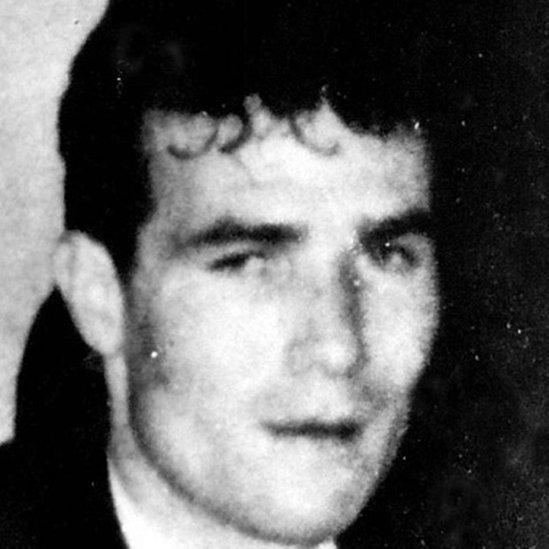Bernard Watt was shot 'as he tried to throw bomb'
- Published

Bernard Watt, 28, was shot by the Army during a riot in Belfast's Ardoyne area in 1971
The inquest into the killing of a man during a Belfast riot 46 years ago has heard soldiers claimed they shot him as he was about to throw a bomb.
Bernard Watt, 28, died after he was shot in Ardoyne in February 1971.
Statements from four soldiers, made at the time, were read out on the first day of a fresh inquest into his death.
One of the soldiers claimed when he shot the man allegedly holding a bomb, he dropped the device which "exploded and blew him down the street".
Mr Watt's family dispute the soldiers' version of events and his widow told the inquest he had no links to paramilitaries.
Petrol bomb explosion
The first inquest into his death was held in July 1971 and resulted in an open verdict.
The current inquest was ordered in 2012 by Attorney General John Larkin QC - one of a number of controversial Troubles killings by the security forces which are being re-examined.
Counsel for the coroner told the court there had been difficulties in tracing and identifying soldiers involved in the case.
In February, the Ministry of Defence defended a Parachute Regiment Facebook appeal asking former soldiers for information about Mr Watt's killing.
The statements described the events of that night when it is said a crowd at Butler Street threw stones, petrol bombs and a nail bomb at soldiers as they moved in to disperse rioters.
The court was told a petrol bomb exploded underneath the front wheels of an armoured vehicle, setting it on fire.
A number of guns and 150 rounds of ammunition which had been left in the vehicle discharged due to the blaze, the inquest heard.
'Authorised to shoot'
The names of the soldiers involved were not revealed in court - they were instead referred to by abbreviations.
A statement from Soldier WO2 B said he saw a man dressed in a dark suit, holding an oblong metal object in his hand.
"I brought my rifle into aim position," he said. "The man went back around the corner. He returned with the object and I fired one round, but he moved out of my line of sight.
"I asked if others could see him and instructed Sgt C and Cpl D to fire - they did," Soldier WO2 B added.
Sgt C's statement said he and Cpl D had been authorised to shoot as it was thought a man might have a bomb.
He said his first round struck a wall but when the man came back again he "aimed for the body, struck him as he turned to throw the device".
"The man fell to the ground and, as he did, so did the object, which exploded and blew him down the street."
He described the man as having medium-length, messy hair and dressed in a dark suit.
Both soldiers said he was then dragged down Chatham Street by an unknown person.
'Irish tricolour'
Mr Watt's widow, Teresa Watt, was at the inquest on Monday to give evidence, and a statement she made in March of this year was read to the court.
In it, she said her husband met a friend, Michael Mailey, at a social club in the area on the night he was killed.
She told the court she heard gunfire as she sat at home.
In her statement, she acknowledged Mr Watt had taken part in rioting previously but said he was not involved with paramilitaries and "never had run-ins with the police or Army".
The court heard his coffin was draped with an Irish tricolour but Mrs Watt said this was to show he was "republican-minded, not part of any organisation".
She said Mr Watt's funeral was not a paramilitary funeral but did tell counsel for the PSNI and Ministry of Defence that she did not attend his burial at Milltown cemetery.
"He was never involved in anything or connected with anything," she added.
Mr Watt's friend Michael Mailey also gave evidence to the inquest.
In a statement read out in court, he said the pair were not drunk and had left a social club to go a nearby pigeon club.
Mr Mailey said they heard shouting that there was rioting on Butler Street and Chatham Street.
'Stretcher'
As they left the club, he said he went to the toilet but that Mr Watt went on to where to rioting was taking place.
He said that within minutes of Mr Watt leaving, he heard two shots and did not recall any further shots being fired.
In his statement, Mr Mailey said he arrived to see a Saracen on fire, after it was targeted with a bomb.
He said he saw a stretcher being carried and he pulled back the sheet to see Mr Watt's body.
Counsel for the PSNI and Ministry of Defence asked Mr Mailey if he had ever known Mr Watt to be a participant in riots.
"No, I've never been in a riot with him," he said. "I've been at riots before. I couldn't say 'Yes, I did know [he had rioted] as it'd only be hearsay.
"Everyone rioted in those days. You got pulled in."
Mr Mailey also refuted any suggestions that men in berets were amongst mourners at Mr Watt's funeral.
"It was not an IRA funeral," he told the inquest.
On Tuesday, the inquest is due to hear from acting State Pathologist Prof Jack Crane, and Soldier E, who was driving the Saracen that was targeted.
- Published3 February 2017